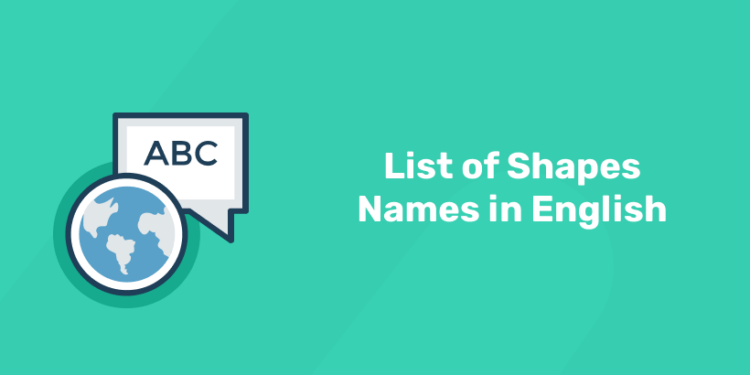Table of Contents
Are you looking for different shape names in English? Here you will find a list of shapes with different types and useful example sentences. If you work in a business that requires the use of mathematics, for example then it would be very important that you are aware of the English names for shapes.
However, this may not be the only reason that you need to learn this information. When taking part in day-to-day conversations, you will need to learn the shape names in order to describe something or be able to understand what someone is talking about, for example, if a person tells you about ‘the square plate.’ Here, you can learn shape names and further expand your vocabulary.
What are Shapes?
Shapes are geometric figures, or the pattern an outline falls into. Shapes are often drawn (whether by ink, pencil, or digitally), but they occur in life, also. Frequently, people picture 2D (two-dimensional, or flat) images when they hear the word “shapes,” so most of the objects listed in this lesson will be 2D shapes, but some will be 3D as well.
Different Types of Shapes
There are many, many different types of shapes, and there are names for basically all of them. The following list focuses on more common shapes that you’re more likely to encounter or to need or want to know the name of.
Learn Spoken English with Aparna Mulberry! Enroll Here!
Shapes Name with Pictures
There are an endless variety of different shapes, and there are names for almost all of them. The list that follows concentrates on forms that are more common and whose names you are more likely to need or want to know.
| Sr No. | Shapes Image | Shapes Name |
|---|---|---|
| 1. |  |
Circle |
| 2. |  |
Square |
| 3. |  |
Rectangle |
| 4. |  |
Triangle |
| 5. |  |
Right triangle |
| 6. |  |
Rhombus |
| 7. |  |
Parallelogram |
| 8. |  |
Cube |
| 9. |  |
Cuboid |
| 10. |  |
Cylinder |
| 11. |  |
Sphere |
| 12. |  |
Hemisphere |
| 13. |  |
Cone |
| 14. |  |
Diamond |
| 15. |  |
Star |
| 16. |  |
Heart |
| 17. |  |
Pentagon |
| 18. |  |
Hexagon |
| 19. |  |
Heptagon |
| 20. |  |
Octagon |
| 21. |  |
Nonagon |
| 22. |  |
Decagon |
| 23. |  |
Semicircle |
| 24. |  |
Quadrilateral |
| 25. |  |
Pyramid |
| 26. |  |
Prism |
| 27. |  |
Trapezium |
| 28. |  |
Trapezoid |
| 29. |  |
Oval |
| 30. |  |
Ring |
| 31. |  |
Kite |
| 32. |  |
Arrow |
| 33. |  |
Cross |
| 34. |  |
Crescent |
| 35. |  |
Tetrahedron |
| 36. |  |
Octahedron |
| 37. |  |
Square pyramid |
| 38. |  |
Hexagonal pyramid |
| 39. |  |
Triangular prism |
| 40. |  |
Rectangular prism |
| 41. |  |
Pentagonal prism |
Circle:

A circle is made of many points whose locus is at an exact distance from the central point. A circle has an angle of 360 degrees, and the length of the outer surface is called the circumference.
Triangle:

A triangle is a closed structure that contains three sides and three angles less than 90 degrees.
Square:

A square is a uniform quadrilateral whose all four sides and angles are equal and of 90 degrees.
Rectangle:

A rectangle is a quadrilateral whose pair of opposite sides are equal, and all angles at vertices are equivalent to 90 degrees.
Right triangle:

The right triangle is also called the right-angled triangle, whose one angle is 90 degrees, and the sum of the other two angles is 90 degrees.
Parallelogram:

A parallelogram is a quadrilateral whose pair of opposite sides and angles (not 90 degrees) are equal in measurement.
Rhombus:

A rhombus is also a square; only the difference is that the opposite angles equal but not 90 degrees.
Star:

A simple star polygon is a combination of polygons that forms an equiangular, equilateral star-like structure.
Cube:

A cube is a 3-dimensional solid square-like structure that contains six faces, 12 edges, and eight vertices.
Cuboid:

A cuboidal is a 3-dimensional solid rectangular structure that contains six rectangular faces, 12 edges, and eight vertices.
Pyramid:

A pyramid is a 3-dimensional structure that has a square ground plan, and outside faces are like triangles that meet at a single point at the tip.
Prism:

A prism is a 3-dimensional solid structure whose parallel faces are polygon, and the other lateral faces are like rectangles. They are named after their parallel faces.
Diamond:

A diamond is a solid-crystalline carbon compound, is the hardest mineral that is colorless, brightest, and is a crystal structure.
Cylinder:

A cylinder is a 3-dimensional solid structure whose curved cylindrical surface is perpendicularly connected with two parallel circular bases. The center of the circular base is called the axis of the cylinder.
Sphere:

A sphere is a 3-dimensional solid celestial figure, which is a closed spherical surface without angles.
Hemisphere:

The hemisphere is a half portion of the celestial sphere separated by the horizon.
Cone:

A cone is a 3-dimensional shape whose base is circular, and the upper surface is curved and meets at the center point above the base.
Heart:

The heart is a shape that looks like a heart-like structure.
Pentagon:

A pentagon is a polygon that has five equal sides, and the angle of the vertices is 108 degrees each.
Hexagon:

A hexagon is a polygon that has six equal sides, and the angle of the vertices is 120 degrees each.
Heptagon:

A heptagon is a polygon that has seven equal sides, and the angles are equal in measure.
Octagon:

The octagon is a polygon that contains eight equal sides, and the eight angles measured 135 degrees.
Nonagon:

The nonagon is a polygon that contains nine equal sides, and nine angles measured 140 degrees each.
Decagon:

A decagon is a polygon that contains ten equal sides, and ten equal angles measured 144 degrees each.
Trapezoid:

A trapezoid is a quadrilateral with two parallel sides, and the other two sides are lateral.
Kite:

A kite is a quadrilateral structure whose adjacent sides are equal in length, and two angles formed by the adjacent sides are equal.
Crescent:

A crescent is a curved shape having two narrow pointed ends. The shape of the crescent looks like a moon, which is less than a half.
Arrow:

An arrow is a combination of a line and an arrow mark at its tip. It is used to point to something or to show some directions.
Cross:

The shape of a cross is made with two lines intersecting each other at their midpoint, forming an angle of 90 degrees.
Quadrilateral:

A quadrilateral is a random four-sided polygon that has neither equal sides nor equal angles of the vertices.
Semicircle:

A half-circle is called a semicircle whose angle is 180 degrees.
Ring:

A ring is a circular band made of a long stripe uses for holding connecting and other purposes.
Oval:

An oval is a shape made by a curve close to a plane that looks like an egg, a compressed circle.
Tetrahedron:

tetrahedron’s shape looks like a triangular pyramid that does not contain any parallel faces or sides, or edges. All vertices are of the same distance from each other.
Octahedron:

An octahedron is a polyhedron with a structure like two pyramids joined to each other from the base sides. It has six vertices, eight triangular faces, and 12 edges.
Square pyramid:

Any pyramid that contains a square base is called a square pyramid. If all the edges of this pyramid are equal, then it is also called an equilateral pyramid.
Hexagonal pyramid:

A hexagonal pyramid has a structure that looks like a pyramid that contains a hexagonal base, and the six triangular faces are isosceles triangles connected to the apex.
Triangular prism:

A triangular prism contains two equilateral triangles, both triangles are connected with three sides, and the edges are parallel to each other. It has three rectangular faces and two similar triangular faces.
Rectangular prism:

The shape of a rectangular prism is the same as that of the cuboid, which has six rectangular faces, and all the opposite sides are the same, having six vertices and 12 edges.
Pentagonal prism:

A pentagonal prism is a solid pentagonal structure that contains two pentagons whose all vertices are perpendicularly connected to each other by edges having six rectangular faces and two pentagonal faces.
Tips to Make Spoken English Better for Malayalam Speakers
Two-Dimensional (Flat) Shapes
- Circle: Circle shapes are a type of geometric figure with a center and radius. The most common type of circle shape is the circle itself. It has two diameters and two radii that intersect at its center point. The next most common type is the ellipse which has one diameter and one radius that intersects at its center point.
- Decagon: Decagon shapes are a type of polygon with ten sides. They have the same number of vertices as an octagon, but they have more edges than an octagon. They are often used in architecture, engineering, and construction.
- Heptagon: A heptagon is a polygon with seven sides. It is also the name of a shape that is made up of seven triangles. Heptagon shapes are very popular in the world of art and architecture. They are also used in various other fields such as engineering, design, and mathematics.
- Hexagon: Hexagon Shapes are a type of geometric shape with six faces, six edges, and six vertices. It is one of the three regular polygon shapes. Hexagons have been used in architecture and engineering since ancient times. They have also been used in the design of jewelry, pottery and other art forms.
- Octagon: An octagon is a polygon with eight straight sides. An octagon may be regular or irregular. In geometry, an octagon is a figure with eight congruent sides, each of which is a triangle.
- Oval: Oval shapes are three-dimensional figures that have four straight sides and a circular top or bottom. It can be used as a design element, as an architectural feature, or as an object such as a vase or bowl.
- Parallelogram: A parallelogram is a quadrilateral that has two pairs of parallel opposite sides. It can also be defined as a rectangle with one pair of parallel opposite sides and the other pair at 90 degrees to the first.
- Quadrilateral: A quadrilateral is a four-sided polygon with four corners. In geometry, a quadrilateral is any polygon that has four sides and four vertices.
- Rectangle: A rectangle is a quadrilateral with four straight sides and four right angles. It is called a rectangle because it can be constructed by connecting two sets of parallel lines through their common point. Rectangles are typically used to create walls and other structures. They can also be found in the natural world as well as in the human body.
- Rhombus: Rhombus shapes are quadrilaterals with two equal sides, two equal angles, and one vertex. Rhombus shapes can also be called rhomboids. This shape is often used in architecture as a decorative element or as a roof shape to make the roof look like it is floating over the walls of the building.
- Triangle: A triangle is a plane figure with three straight lines forming its sides and three vertices in its interior. Triangle shapes are very important in the world of art, architecture, and design. They are also used in mathematical proofs and everyday objects such as doors and windows.
Three-Dimensional Shapes
Three-dimensional shapes are ones that aren’t just flat on paper, but also take up room vertically. Only a few are really commonly named.
- Cube: A cube is a solid object with six square faces, eight vertices, and twelve edges. A cube is the most common shape in the world, but it has many different uses. In fact, there are many different types of cubes that can be used for various applications.
- Cylinder: Cylinder shapes are one of the most basic forms of three-dimensional geometry. They are composed of a straight line and two circles. The straight line is called the axis and the circles are called bases.
- Sphere: The sphere is a three-dimensional shape that has the property of being the surface of a continuous curve. It is often used as an idealized geometric form to represent the concept of something around which there is no limit.
- Cone: A cone is a three-dimensional figure that resembles a circular base, with one point at the top and two converging sides. Cones are typically used as a tool in architecture and construction to define the shape of a building.
- Pyramid: A pyramid shape is a three-dimensional shape with a polygonal base and triangular sides. The earliest known pyramid shape was seen in the architecture of ancient Egypt.
- Prism: Prism shapes are a type of circle that has a triangular cross-section. The triangle is made up of three arcs, each of which is tangent to the other two. Prism Shapes are the most popular shapes in jewelry. They are a combination of curves, angles, and circles that can make the perfect statement.
- Hemisphere: The term hemisphere is used to describe a curved surface that is round in shape. It can also be used to describe a sphere or ball.
- Tetrahedron: A tetrahedron is a polyhedron with four triangular faces. It has six edges and four vertices. Tetrahedron Shapes can be found in nature and architecture. They are also used in many different fields such as chemistry, physics, mathematics, and engineering.
List of 40+ Musical Instruments Names in English
Shapes Name in Maths
- Triangle
- Cube
- Hexagon
- Square
- Circle
- Semicircle
- Rhombus
- Parallelogram
Geometrical Shapes Name
- Circle
- Semicircle
- Oval
- Triangle
- Square
- Rectangle
- Parallelogram
- Rhombus
- Trapezium
- Kite
- Pentagon
- Hexagon
- Heptagon
- Octagon
- Nonagon
- Decagon
- Cube
- Cuboid
- Cone
- Cylinder
- Sphere
Benefits of Teaching Shapes to Children
Here are some benefits of teaching children the shape names in English:
1. Improved Verbal Skills
While learning shapes for kids, the little ones acquire a varied set of skills, such as verbal communication, that comes in handy when they practice describing the shapes they see.
2. Pre-writing activity
This also plays a role in pre-reading and writing as Kids are getting the basis for number and letter identification.
3. An introduction to Geometry
It is the first step to learning geometry, that will serve as an asset for future math learning.
4. Develops creativity
Children will be able to think creatively when they learn about shapes. These shapes for the basis of many patterns and designs which they will learn in their drawing class.
5. Improves observation skills
It will enhance the kids’ experience in life by encouraging them to observe the world, establishing useful connections between objects and teaching them better appreciation of art.
6. Boosts imagination power
Learning about shapes also makes kids more imaginative as they progress from learning 2-D shapes to 3-D shapes.
Ways To Teach Shape Names For Kids
Following are some creative ways to teach kids about shapes with kindergarten activities
1. Make shapes
Instead of making them directly on paper, you can make them fun by creating them with the help of straws, toothpicks, etc. Ask your kid to make the different shapes themselves using these props. It is one of the best shape activities for preschoolers.
2. Use Objects
You can use things from your surroundings to clear the shape confusion. Tell them about the shape they see in their surroundings. For instance- the table is round in shape; the clock has a square shape, etc. This way, they will get a better understanding.
3. Play a Guessing Game
You can get some shape flashcards from the market for teaching them to your toddlers. You can keep them in front of the kid and ask them to guess the shape. Also, praise them when they get it right.
4. Drawings
You can make a hut, lamp, or other things which include 2-3 shapes. You can cut these shapes and ask your kid to join them to make something out of them. It will increase their mental sharpness as well. This activity will make them learn geometric shapes names.
Some Examples of Objects and Their Shapes
Here are a few examples of objects and their shapes for your reference.
| Name of the Object | Shape of the Object |
| Sun | Sphere |
| Moon | Sphere |
| Earth | Sphere |
| Triangle (musical instrument) | Triangle |
| Box | Cube/Cuboid |
| Television Screen | Rectangle |
| Ring | Circle |
| Jar | Cylinder |
| Ice cream cone | Cone |
| Birthday hat | Cone |
Learn Spoken English with Aparna Mulberry! Enroll Here!











